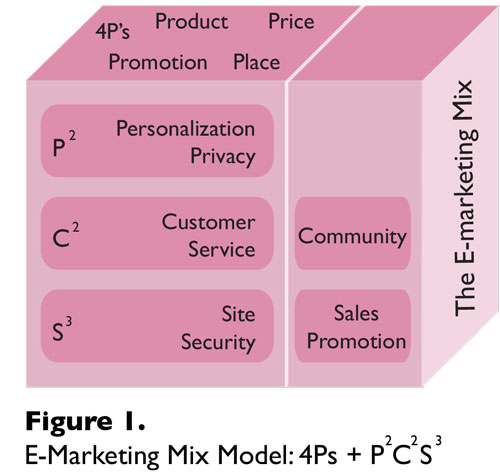E-marketing strategy is normally based and built upon the traditional 4Ps (Product, Price, Promotion and Place), which forms the classical marketing mix. However, e-marketing’s uniqueness can be created by using a series of specific and relational functions that are combined with the 4Ps to form the e-marketing mix elements, each of which contain associated e-marketing mix tools that are provided on business websites to facilitate sales transactions.
During the last 20 years, the popularity of the Internet has been growing exponentially. As a result of the increased utility and bandwidth of Internet communications, the use of web browsers has increased dramatically over the last ten years. Thousands of businesses have exploited this great opportunity to create their own websites that allow customers to purchase products directly from their browsers. Most commercial companies believe that they can generate a large amount of profit from the web. The collapse of dot-com boom caused many online businesses to terminate operations from April 2000 to December 2001. However, those e-retailers that developed and introduced new internet-based marketing techniques (e-marketing), which were integrated into their current marketing strategy, managed to increase their business activities. Marketing operations should now be focusing on developing new paradigms for electronic commerce on the Web, rather than using the existing primitive 4Ps structure. Many new models have been developed to replace the 4P model in the digital marketplace including the 4C model, 4S model and 4Ps + P2C2S3 model. This study investigates consumers’ perceptions about the e-marketing mix provided by online business stores in order to facilitate sales transactions. The adopted e-marketing mix model should be based on the consumers’ viewpoint.
The web-marketing mix 4S model is based on the organisation’s viewpoint in addition to the consumers’ viewpoint. This requires the identification of strategic objectives, classification of the potential competitors and customers of the site, assessment of the degree of readiness of the company for e-commerce, or recognition of the co-operation with other Internet partners outside the organisation. This expensive investment is not required for the system reported herein
For the 4Cs model, it is a customer-oriented marketing mix model, which is quite relevant to this research. However, one of the 4Cs, satisfying Consumer’s costs, does not only concern price, which may be one of the most important factors in a consumers’ purchasing decision. For the other Cs, they mainly focus on developing relationships with consumers.
[ms-protect-content id=”9932″]
E-Marketing Mix – 4Ps+P2C2S3 Model
Van Waterschoot and Van den Bulte1 pointed out that the components of “communication” address “barriers to wanting”, whereas the sales promotion function addresses “barriers to acting”. They observed that “triggers to customer action” seem necessary in certain situations to induce the exchange. Hence, Van Waterschoot and Van den Bulte termed sales promotion a “situational” function. On the basis of these distinctions, the marketing mix can be reclassified into the “basic mix” and the “situational mix”. In addition, since the sales promotion mix can apply across the full spectrum of the basic mix (the rest of the traditional marketing mix), it is considered by Van Waterschoot and Van den Bulte to be overlapping. The concepts developed by Van Waterschoot and Van den Bulte can be summarised in the form of the following axioms:
Axiom 1: Marketing functions are the appropriate properties for the classification of marketing tools.
Axiom 2: Some functions are essential and others are situational in nature.
Axiom 3: Some functions have a moderating effect across other marketing functions and are called overlapping functions.
Axiom 4: Functions are accomplished by marketing tools.
Axiom 5: A tool can serve one or several functions.
Based on the above axioms, Kalyanam & McIntyre2 created a new E-marketing mix 4Ps+P2C2S3 model as illustrated in Figure 1. The model consists of i) more components than 4Ps model in order to reflect the E-Commerce environment and ii) e-marketing tools, which can influence consumer retention on the Internet and play an important role in the formation of an effective e-marketing strategy, mapped into each component.
In the 4Ps+P2C2S3 model, there are some customer-oriented e-marketing tools such as i) product configuration engine, ii) product image viewing tools, iii) online product discussions among consumers and iv) security techniques. For i), Maru Winnacker, the CEO of Project OONA, strongly believes that mass customisation offers huge potential in the online market and it can bring customers and online retailers closer together. For ii), according to Linda Bustos, Director of Ecommerce Research at Elastic Path, many product items cannot be fully described with words and other tools such as: enlarged images with different colours, zooming and back views can better describe the product items. For iii), Nielsen Company stated that the average social networking visitor is now spending almost 6 hours in April 2010, versus 3 hours, 31 minutes last year, an increase of almost 60% in one year. According to a recent survey3, more than half of all marketers are currently engaging in some form of social media activity with about 60% of them planning on increasing their spending in the near future. After friends and family, the number one driver for brand trust is online reviews and feedback from social networking, according to Nielsen Company. As a direct result, advertisers are moving from a more traditional broadcasting based marketing relationship with online consumers to a more interactive based marketing relationship, where consumers directly engage with marketing messages and pass them along to their friends via social networking sites. As a result, the social networking sites can greatly affect online consumers’ buying decision. This concern has been addressed in the 4Ps + P2C2S3 model. For iv), despite the high number of online shoppers, it seems that only a small percentage – 12% – of the European Internet users are truly confident when buying online due to the security and privacy concerns. Based on the above observations, the 4Ps + P2C2S3 model is the most suitable choice for this research.
Regarding the 4Ps + P2C2S3 model, there has not yet been significant research on the analysis of the importance of e-marketing tools relative to their associated e-marketing mix elements. The purpose herein is to evaluate how successful a business website implements its e-marketing mix in a B2C environment.
Methodology
There are two e-marketing tools (Forward Auctions and Reverse Auctions) omitted from our research as they are not relevant in a B2C environment. In order to analyse the importance levels of e-marketing tools supporting the corresponding e-marketing mix elements, a survey was performed and the e-marketing tools are converted to survey items , each of which was measured on a scale from one to five, starting from “strongly agree” to “strongly disagree”. The survey data for the analysis were obtained from 263 online consumers, some of whom were students and some were in employment. The sample data had a mean age of 32.5 years and was evenly divided by sex.
For the data analysis process, confirmatory factor analysis was adopted to i) determine if the number of factors conform to the 4Ps + P2C2S3 model and ii) evaluate the importance levels of e-marketing tools supporting the corresponding e-marketing mix elements. Furthermore, the varimax rotation method is employed to facilitate the interpretation of factors.
The results of factor analysis categorise the 28 items into 11 factors (e-marketing mix elements), which conform to the 4Ps + P2C2S3 model. Since most of the alpha coefficients have values of around or above 0.7, the items are said to have at least acceptable internal consistency. In addition, the factor loading of an item indicates the correlation coefficients between the item and the corresponding factor. Hence, the loading of an item refers to the weight of the item used to contribute to the corresponding factor.
Calculation of Relative Weights of E-Marketing Tools
The relative weight of each item (e-marketing tool) is computed according to the ratio of each item’s factor loading to the sum of the absolute factor loadings of all items relative to their associated factors, respectively. The formula is summarised as follows:
where, RWi is the relative weight of the ith e-marketing tool with respect to a particular e-marketing mix element and Loadingi is the loading of the ith e-marketing tool with respect to a particular e-marketing mix element.
Discussions of the weights of e-marketing tools
Based on the relative weight of each e-marketing tool, the product configuration tool has the highest relative weight (0.404); thus making it the most important e-marketing tool in the product element, hence, offering different product categories is more important than product viewing tools. For the promotion element, newsletter email (0.294) is relatively more important than suggestions regarding complementary items (0.194). For the price element, dynamic pricing in business web sites is more important than allowing customers to enter target price. With regard to personalization, the notice of new items (0.43) and suggested items (0.36) related to consumers’ interest is more important than the notice of recently browsing items (0.21). For the customer service element, quick response from e-mail enquiry is the most important e-marketing tool while the chat room between customers and supporting staff is the least important one. For community element, online product discussions among customers (0.504) are very important while wish list (0.193) is not important. For site element, organised contents are most important (0.338) although the other two e-marketing tools (clear features and product categories) have similar weights.
Conclusion
By evaluating the relative weight of each e-marketing tool with respect to its e-marketing mix element, the importance level of each e-marketing tool corresponding to its e-marketing mix element can be ranked. For the Product element, the most important e-marketing tool is the configuration tool, while the online advertisement and newsletter are very important for the Promotion element. This guideline is very important for online stores when they are developing e-marketing plans since the relative weight of each e-marketing tool plays a very important role for evaluating the overall performance of the e-marketing mix based on the supporting e-marketing tools. One of the future enhancements of this research is to develop an e-marketing mix analyser tool to provide analysis capabilities to support e-marketing tools for online stores. The purpose is to allow online stores to develop more effective e-marketing plans based on the analysis of their e-marketing tools.
About the Authors
Kin Meng Sam is now an assistant professor at the Department of Accounting and Information Management at the University of Macau. He has published a few conference and journal papers regarding to online consumers’ decision-making styles, e-marketing mix and ontology. In 2010, he was elected as a member in Graduate Studies Committee. He is currently a member at the Academic Council Committee in the University of Macau. In addition to his interest in e-marketing mix, he is also actively involved in studying i) online consumers’ decision-making styles, ii) business ontology and iii) text-mining system.
Chris Chatwin is a professor in the Department of Engineering and Design, School of Engineering and Informatics, University of Sussex, United Kingdom. He holds the Chair of Engineering, University of Sussex, UK; where he is Research Director of the “iims Research Centre”. He has published two research monographs: one on numerical methods, the other on hybrid optical/digital computing – and more than two hundred international papers. His current interests include i) recognition, tracking, surveillance & security systems, ii) informatics, communications & space, iii) biomedical diagnostics & prognostics and iv) e-commerce.
References
1. Van Waterschoot, W. and Van den Bulte, C. (1992) The 4P Classification of the Marketing Mix Revisited, Journal of Marketing, volume 56, issue 4, pp. 83-93
2. Kalyanam, K., and McIntyre, S. (2002) The Marketing Mix: A Contribution of the E-Tailing Wars, Journal of the Academy of Marketing Science, volume 30, issue 4, pp. 483-495
3. Ramsey, G. (2010). 10 Best Practices for Success with Social Media. New York, NY: eMarketer.
4. For more information about the survey items of this research project, please see “Measuring E-Marketing Mix Elements for Online Business” by Sam, K. M. & Chatwin, C. R., International Journal of E-Entrepreneurship and Innovation, vol. 3, no. 3, pp. 13 – 26, 2012





































